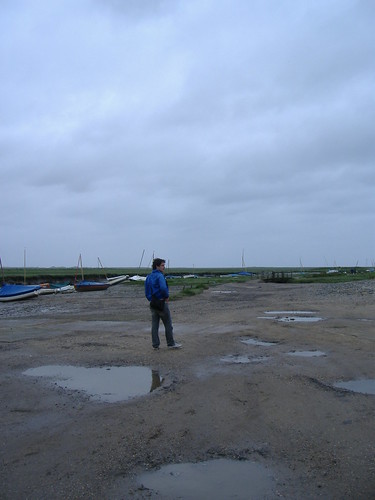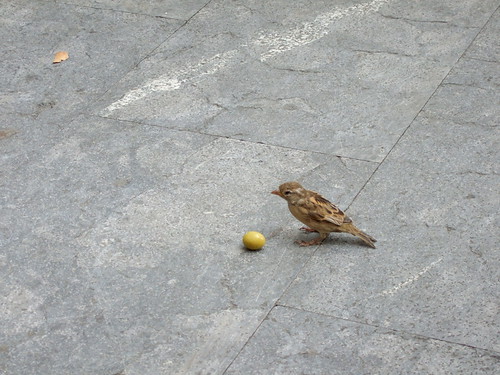
Margitsziget, between the Margit and Arpád Bridges, is two and a half kilometres long, an insular pleasure ground for Budapesters from March until September. There are two thermal baths, one attached to an Olympic-sized pool and sporting complex designed by the Hungarian Olympian, and modernist architect, Alfréd Hajós.
 In addition to this, there is a neat football and athletics stadium, bicycles to hire, food stalls, ponds, fountains, and a variety of picturesque ruins (follies, perhaps) secreted in woods. During autumn and winter, though, the trees are bare, and the leaf-fall makes usage of the outdoor pools unviable. Rooks congregate in the branches and pelt nuts to the roadways below with their beaks - a hazard for the runners who lend a semblance of vitality to the island at this time of year - to expose the edible core.The debris of autumn is piled against walls; occasionally, a flaking bus disturbs the quiet.
In addition to this, there is a neat football and athletics stadium, bicycles to hire, food stalls, ponds, fountains, and a variety of picturesque ruins (follies, perhaps) secreted in woods. During autumn and winter, though, the trees are bare, and the leaf-fall makes usage of the outdoor pools unviable. Rooks congregate in the branches and pelt nuts to the roadways below with their beaks - a hazard for the runners who lend a semblance of vitality to the island at this time of year - to expose the edible core.The debris of autumn is piled against walls; occasionally, a flaking bus disturbs the quiet.
At the northern tip of the island a few ducks shuttle aimlessly about on green water and pairs of old women amble beside drained pools (evocative of Ballard, Borges, and Bioy Casares), their hoods pulled up. Maybe they're discussing ailments. Behind another thicket is a tramp sleeping on a bench, his face turned away from anyone who might happen to pass by. Underneath the slip road onto the Arpád Bridge, however, a communist-era hotel remains open throughout the year: it is now part of the 'Danubius' chain, whose logo feels ubiquitous in Budapest.
The Arpád Bridge carries a six lane highway and tramline 1A over the Danube, linking the hills and apartments of Obuda to the high-rise office blocks of the XIIIth District. It is the mosth northerly road bridge in the city centre and from it one can see the lights of trains crossing the steel box-frame of the North Rail Bridge about a kilometre upstream. The Arpád is probably the least conventionally attractive of all the city's river crossings, but to walk across it during evening rush hour (and hour or so earlier than in the UK) is perhaps one of the best ways to gauge both the scale of Budapest and the dynamic that exists between its two mismatched components. One might presume that a car travelling westwards at this time belonds to a well-paid businessman, leaving the financial district to return to a house in the Buda Hills (if Budapest is of similar size to Greater Manchester, the Hills are its Saddleworth or Alderley Edge.) I wonder who makes the opposite journey.

We walk back towards the Nagykorut through the postwar tower blocks which comprise the residential elements of the XIIIth, joining the Great Boulevard and its after-work shoppers just above Nyugati Station, buzzing in the dusk with Eliotic commuters. It feels odd, even improper, to walk on and off an island, especially by different bridges, thus making it one half of a route's ellipse.

We walk back towards the Nagykorut through the postwar tower blocks which comprise the residential elements of the XIIIth, joining the Great Boulevard and its after-work shoppers just above Nyugati Station, buzzing in the dusk with Eliotic commuters. It feels odd, even improper, to walk on and off an island, especially by different bridges, thus making it one half of a route's ellipse.



3 comments:
wow. thanks for sharing this. it's like reading sebald...
That's where Neil and I stayed a couple of years ago! At the Danubius hotel (though in the old building, not the forbidding concrete one); fond memories of honeymoon-period getaway... ah. It may or may not interest you to know that the 2 separate buildings are linked by a tunnel, allowing guests in the old building to access the spa facilities in the new.
Many years ago I would have happily shared some other entertaining detail... but hey, that was when we could drink wine all night and weren't grown-ups, obviously. xx
Ernesto - thanks. That's high praise indeed. Sebald would never have tolerated my split infinitives, though, or so I've been told.
Hope you're feeling better today.
Post a Comment